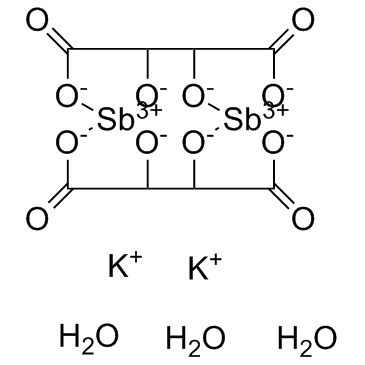Axenically cultured amastigote forms as an in vitro model for investigation of antileishmanial agents.
D Sereno, J L Lemesre
文献索引:Antimicrob. Agents Chemother. 41(5) , 972-6, (1997)
全文:HTML全文
摘要
Using a 3-(4,5-dimethylthiazol-2-yl)-2,5-diphenyltetrazolium bromide microassay, previously described as a means of quantifying Leishmania amazonensis in vitro at the amastigote stage (D. Sereno and J. L. Lemesre, Parisitol. Res., in press), we have compared the activities of seven drugs, including those currently used to treat leishmaniasis, against axenically grown amastigote and promastigote forms of three Leishmania species (L. amazonensis, L. mexicana, and L. infantum, responsible for diffuse cutaneous, cutaneous, and visceral leishmaniasis, respectively). The ability of axenically cultured amastigote organisms to be used in an investigation of antileishmanial agents was first evaluated. We have confirmed the toxicities of sodium stibogluconate (Pentostam), pentamidine, and amphotericin B to active and dividing populations of axenically cultured amastigotes. The toxicity of potassium antimonyl tartrate trihydrate, which is generally higher than that of Pentostam, seemed to indicate that pentavalent antimony can be metabolized in vivo to compounds, possibly trivalent in nature, which are more active against the amastigote organisms. When the drug susceptibilities of parasites at both stages were compared, great variations were found for all the drugs studied. These major differences, which show the specific chemosusceptibility of the parasite at the mammalian stage, demonstrate the potential of using cultured amastigotes instead of promastigotes in a drug-screening procedure for early detection. This in vitro model may help in the isolation of active compounds, particularly those with low-grade activities, against the mammalian stage of the parasite.
相关化合物
| 结构式 | 名称/CAS号 | 分子式 | 全部文献 |
|---|---|---|---|
 |
酒石酸锑钾
CAS:28300-74-5 |
C8H4O12Sb2.3H2O.2K |
|
Lower nitric oxide susceptibility of trivalent antimony-resi...
2005-10-01 [Antimicrob. Agents Chemother. 49(10) , 4406-9, (2005)] |
|
Therapy and disease concepts: the history (and future?) of a...
2002-01-01 [J. Hist. Med. Allied Sci. 57(1) , 61-78, (2002)] |
|
Monitoring of intracellular nitric oxide in leishmaniasis: i...
2011-01-01 [Cytometry. A 79(1) , 35-45, (2011)] |
|
Effects of antimony on aquatic organisms (Larva and embryo o...
2009-05-01 [Chemosphere 75(7) , 889-93, (2009)] |
|
Cys-113 and Cys-422 form a high affinity metalloid binding s...
2006-04-14 [J. Biol. Chem. 281(15) , 9925-34, (2006)] |